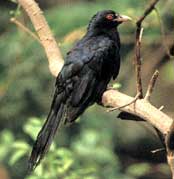
Custom Search
Indian Koel
by Lakshmi Menon
(Bangalore)
Little Swetha was playing alone in the backyard of her house. She was feeling lonely and waited for her friends from the neighbor houses to come and play with her. Suddenly she heard a beautiful song of a bird from the top of her house. She looked up and spotted a black bird there. Though it was black looking something like a crow, he sang beautifully and Swetha was very happy. She forgot about her loneliness in the company of the bird.
As there was no sound from Swetha, her mother got worried and left her job in the kitchen and came to the backyard to find out about her daughter. Amazingly, she found Swetha in a very happy mood engrossed in the cuckoo’s song.
But when the bird saw her mother he flew away.
“O mama! What a nice bird? Such a beautiful song? What is the name of this bird, mama?” Swetha wanted to know more about the bird, which made her happy all this time.
“This bird is called Cuckoo or Koel. Cuckoo is a small bird seen all over India. They are also found in many Bird Sanctuaries in India. Cuckoos are also seen in Australia. A cuckoo has a length of 39-46 cms," said her mother, sitting next to her daughter.
By then Swetha’s friends – Reema and Sujith - came and joined them.
“Mummy, tell me more about cuckoo,” demanded Swetha.
“Okay. I’ll tell you everything about this bird.
I know what all questions you will have, and I will answer them one by one. Listen carefully.”
“Aunty, what is the zoological name of a cuckoo?” asked Sujith who was a 5th standard student.
"The zoological name of cuckoo is Eudynamys scolopacea."
“Aunty, how do they look in appearance?” That was Reema’s question.
"A cuckoo has a long tail, pointed wings and curved bills. A cuckoo’s tail is dark gray and slightly white in colour. The crown is dark brown and the bill is pale green in colour."
"How do we differentiate them whether they are males or females? Asked Sujith."
"A male cuckoo is glistening black, with yellowish green bill and crimson eyes. They have short wings but long tail".
Female cuckoos are slightly smaller than the males. A female cuckoo has green beak and red eyes. The female is dark brown, with profusely spotted and barred with white. They have green beak and red eyes," said Swetha's mother.
“Mummy, what do they eat? Who gives them food?”
"Cuckoos are carnivorous. You may wonder what is carnivorous? It means they eat flesh"
"They eat fruits, insects,caterpillars, grasshoppers, lizards, small snakes and mammals."
The children looked at each other in surprise.
"Where do they live? Do they have houses like us?" asked Swetha.
Her mother smiled. "They live on the canopy of the trees, where they make their nests."
"How do they get brothers and sisters?" Reema wanted to know.
"A mother cuckoo lays egg in the nest of the other bird. Once the egg is hatched the chick forces the other eggs and hatchings out of the nest. The babies have dark eyes. When the chick leaves the nest it roosts in the outer branches of a tree."
"A mother koel lays her eggs in the nest of a crow. After laying the eggs, the female koel flies away to the dense forests as it likes to live on big trees full of leaves to hide it. Their eggs are hatched by the crow." She added.
"Very interesting! Aunty, when is their breeding season?" asked Sujith.
"The breeding season of Cuckoos is September to March," replied Swetha's mother.
"Do they always sing like this?" asked Swetha.
"No. They usually sing in spring season because it is their mating season. The males sing such beautiful song to attract the female ones."
"How sad we missed watching the cuckoo singing!" Reema was disappointed.
"Don't worry, Reema. I have a video of a cuckoo singing. Watch this video. All of you come inside and I will switch the computer on," said Swetha's mother.
The children rushed inside enthusiastically to watch the video.
Comments for Indian Koel
|
||
|
||
|
||
|
||
|
||
|
||
|
||
|
||
|
||
|
||
|
||
|
||
|
||
|
||
|
||








